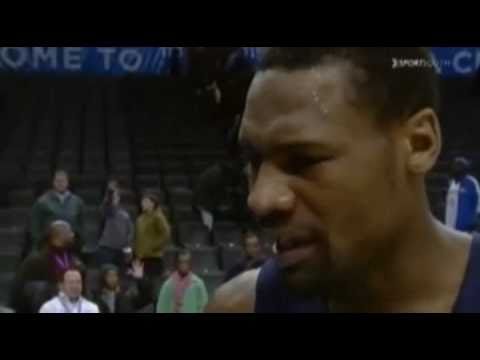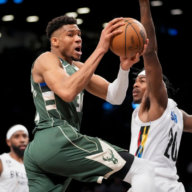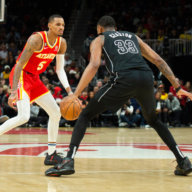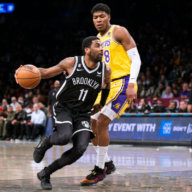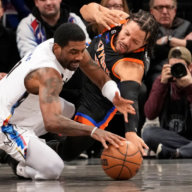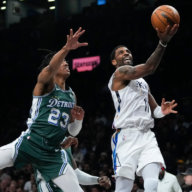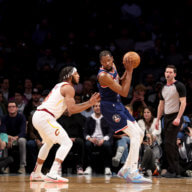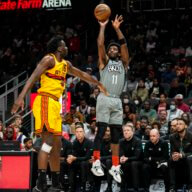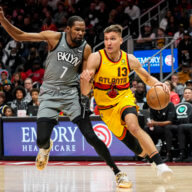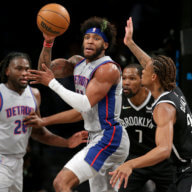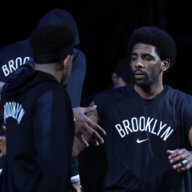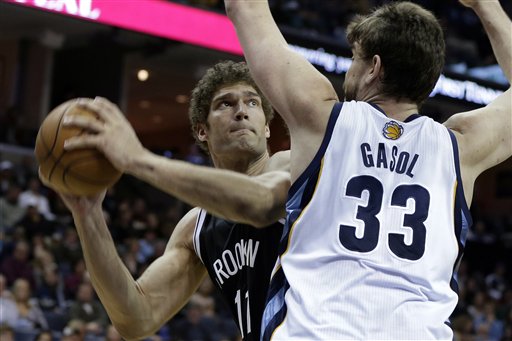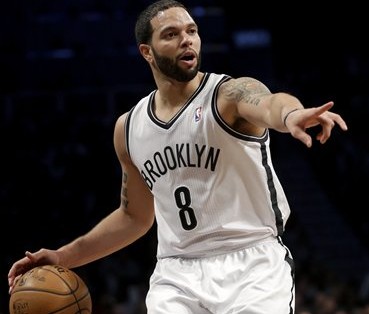In February 2011, after what seemed an improbable win over the Oklahoma City Thunder, Tony Allen described the Memphis Grizzlies effort in four simple words: “All heart. Grit. Grind.”
From that day forward, Lionel Hollins’ team had a defense-first, paint-pounding identity.
After looking at how Lionel Hollins’ offensive system fit with Nets personnel, here’s the driving force behind the “Grit and Grind” Grizzlies — and if Lionel Hollins can bring those winning habits to Brooklyn.
The Defense
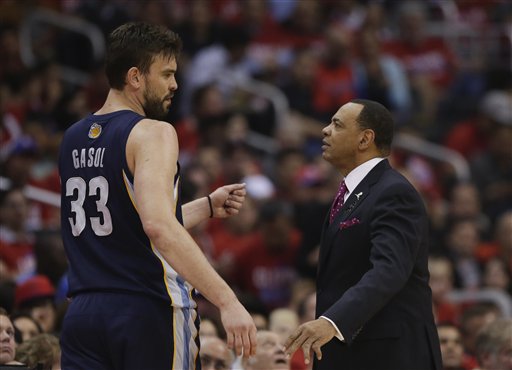
Grit-and-Grind is a philosophy that describes playing against Memphis: the extra bump you get cutting through the lane from Marc Gasol, the tenaciousness displayed by Tony Allen fighting through a screen.
Much like Hollins’ pick-and-roll oriented offense, the Grizzlies ran the same defense most of the NBA runs now, Tom Thibodeau’s strong-side zone. The Brooklyn Game’s Devin Kharpertian succinctly described the zone here in 2013: “(F)orce every screen baseline, overload the strong side with defenders (which is allowable under the NBA’s zone rules), and cut off passing and driving angles in the middle of the floor.” Each player has a role defined by rules so precise, he uses a tape measure to demonstrate a defender’s exact position.
Hollins employed Thibodeau’s general principles, while trusting a few of his players to improvise and cheat the rules a bit in search of turnovers. That resulted in a defensive rating of 100.3, good enough for second in the league in 2012-2013. A 15.2% forced turnover rate, also second overall. 703 cumulative steals – a paltry fourth. Can we expect similar results from Hollins in Brooklyn?
In Brooklyn
The Nets are not new to this zone. Lawrence Frank, as assistant coach, defensive coordinator, and pre-reporter last season, tried installing Thibodeau zone principles with little success. The Nets hit their stride later in the season, after Lopez went down due to injury, utilizing some of the zone’s concepts while playing a much more aggressive pick-and-roll defense.
So Frank couldn’t make it work. Kidd had to adjust it to personnel. Can Hollins?
When we took a look at Hollins’ offense, an old adage range true: a coach is only as good as his personnel. The optimism: if healthy, the Nets shooters can elevate Hollins’ pick-and-roll system.
The downside: we may have to cut Hollins some slack on defense.
Guards in the strong-side zone position their body between the screener and the ballhandler, to force (or “down”) the action towards the baseline. This limits the action to one half of the court.
This is a role well suited for many of the Nets bigger-bodied guards: Williams, Anderson, Johnson, perhaps Bogdonavic. The Nets mostly completed this task with occasional spurts of inattentiveness, an error Hollins’s colorful teaching style could clean up.
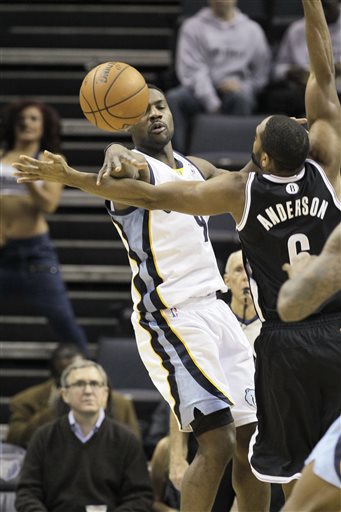
Alan Anderson played a similar but less effective Tony Allen-esque role with Brooklyn last season. He’ll likely earn the tough defensive assignments, but not in a starter’s role.
Brook Lopez’s return is another reason to dial the grit-and-grind back. He is no Marc Gasol, Memphis’s 2013 NBA Defensive Player of the Year Award. Gasol did a little bit of everything: shifting in and out of the paint to evade the three-second rule and deter movement towards the basket, corralling ballhandlers at the elbow to deny them a paint touch, and protected the rim on the occasion that the defense broke down.
Lopez shed his reputation as a minus defender in recent seasons, but still falls well short of the Defensive Player of the Year conversation. The rim is Lopez’s oxygen tank: he thrives near it, but drowns the further he’s pulled from the paint. The strong-side zone requires the center to move around and outside the paint to avoid the three-second rule, while obstructing the paint from ball handlers and passes alike. That’s a lateral quickness that the Brookie Monster does not possess.
On the pick-and-roll, the zone requires the center to sag below the pick, ceding a mid-range shot to deny the ball handler access to the paint. It is a conservative approach to pick-and-roll defense. That’s what Lopez normally does anyway, because he struggles with adept ball handlers that take advantage of his slow-footedness. (To his credit, centers like Roy Hibbert experience similar difficulties.)
In contrast, Kevin Garnett (if he’s still alive) and Mason Plumlee can flourish in this role. Plumlee is in an enviable position for a young center, able to learn from future Hall of Famer Garnett, and the same coach that developed Marc Gasol. Plumlee’s foot speed and Hollins’ persistence may craft a fine anchor for a Thibodeau zone in Brooklyn.
Garnett, even at 37, proved an effective anchor on defense. During the regular season, Garnett held the league’s best defensive efficiency against pick-and-roll screeners, per the Bleacher Report (citing Synergy Sports). Further proof: the team’s defensive rating climbed roughly 6 points each time Kevin Garnett left the court.
There are two roles for the forwards in this scheme. On the weak side, a forward keeps his foot in the paint, ready to rotate to a guard who gets past a center at the “nail” (the free throw line), or to bump a roll man with a clear view to the rim. On the strong side, the forward assumes a strict position between the paint and the corner three-point line to cut off lanes to the paint, crowd the ball handler, and close out on any corner three-point shots.
Joe Johnson played well in the forward role, only occasionally failing to secure a defensive rebound. Andrei Kirilenko’s length and relative speed give him excellent prospects as well.
An interesting wrinkle to consider: Kirilenko may even prove an effective stopgap at center, with Kirilenko roaming the paint while Lopez mans a traditional forward spot. There’s a risk-reward here: Lopez may bolster the weak-side defense with exceptional last-line rim protection, but would struggle mightily closing out on shooters. Conversely, the strong-side zone may hide some of Mirza Teletovic’s shortcomings, and though he’s not a Zach Randolph-level rebounder, Teletovic is able to clean up the boards.
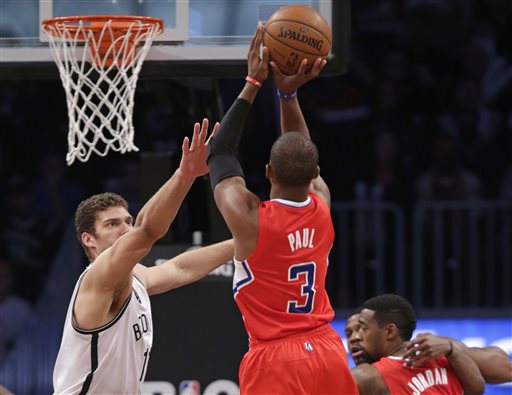
How should the Nets define success?
We have no idea what’s running through Hollins’ mind right now, save maybe that it involves a cuss word or two. Hollins could take one could look at his core and scrap the zone all together, or figure out some innovative old-school way to make it work in this NBA.
Last season, the Nets earned a defensive efficiency rating of 104.9, 19th in the league, a number unlikely to satisfy the demanding Hollins. After January 1st, The Nets posted a more respectable 103.9 defensive rating, the 12th most efficient defense in the league during that period. If Hollins can replicate or even improve upon the latter number, he not only enhances his image as defensive guru, he’ll set this roster up for playoff contention.

